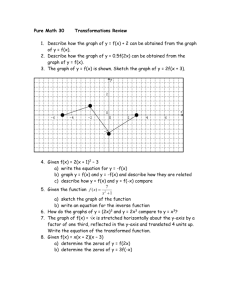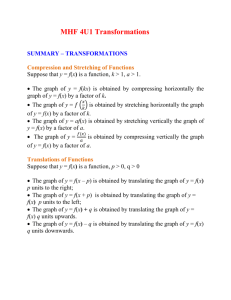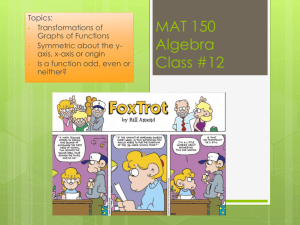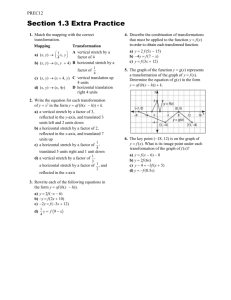chapter 3 answers
advertisement
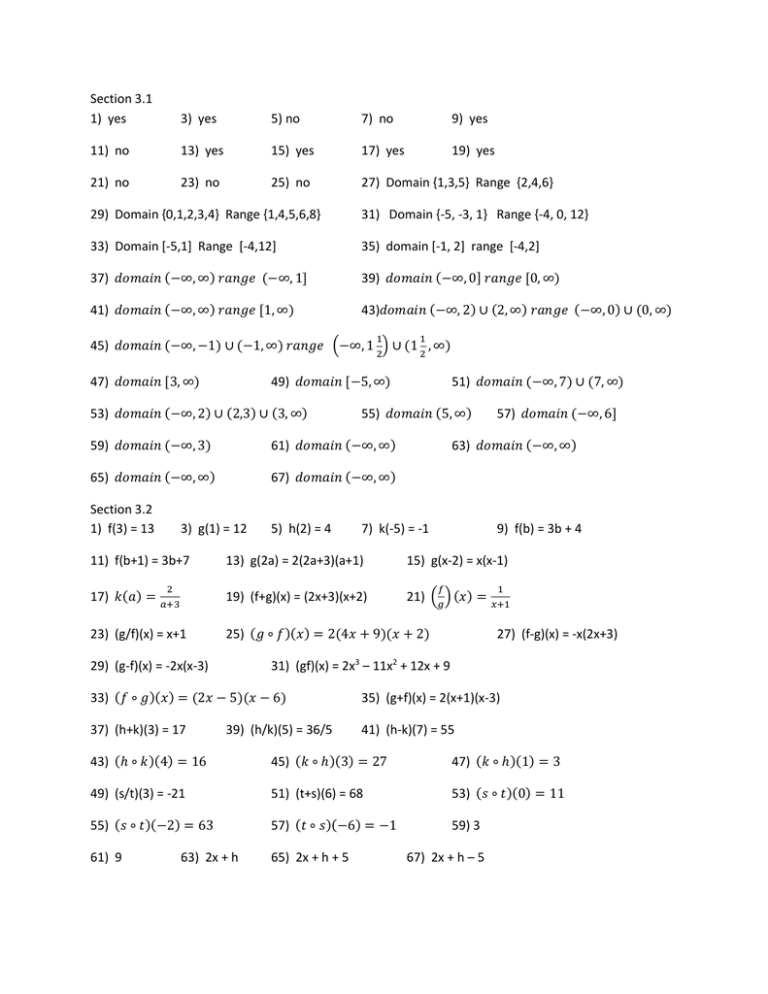
Section 3.1
1) yes
3) yes
5) no
7) no
9) yes
11) no
13) yes
15) yes
17) yes
19) yes
21) no
23) no
25) no
27) Domain {1,3,5} Range {2,4,6}
29) Domain {0,1,2,3,4} Range {1,4,5,6,8}
31) Domain {-5, -3, 1} Range {-4, 0, 12}
33) Domain [-5,1] Range [-4,12]
35) domain [-1, 2] range [-4,2]
37) 𝑑𝑜𝑚𝑎𝑖𝑛 (−∞, ∞) 𝑟𝑎𝑛𝑔𝑒 (−∞, 1]
39) 𝑑𝑜𝑚𝑎𝑖𝑛 (−∞, 0] 𝑟𝑎𝑛𝑔𝑒 [0, ∞)
41) 𝑑𝑜𝑚𝑎𝑖𝑛 (−∞, ∞) 𝑟𝑎𝑛𝑔𝑒 [1, ∞)
43)𝑑𝑜𝑚𝑎𝑖𝑛 (−∞, 2) ∪ (2, ∞) 𝑟𝑎𝑛𝑔𝑒 (−∞, 0) ∪ (0, ∞)
1
2
1
2
45) 𝑑𝑜𝑚𝑎𝑖𝑛 (−∞, −1) ∪ (−1, ∞) 𝑟𝑎𝑛𝑔𝑒 (−∞, 1 ) ∪ (1 , ∞)
47) 𝑑𝑜𝑚𝑎𝑖𝑛 [3, ∞)
49) 𝑑𝑜𝑚𝑎𝑖𝑛 [−5, ∞)
53) 𝑑𝑜𝑚𝑎𝑖𝑛 (−∞, 2) ∪ (2,3) ∪ (3, ∞)
55) 𝑑𝑜𝑚𝑎𝑖𝑛 (5, ∞)
59) 𝑑𝑜𝑚𝑎𝑖𝑛 (−∞, 3)
61) 𝑑𝑜𝑚𝑎𝑖𝑛 (−∞, ∞)
65) 𝑑𝑜𝑚𝑎𝑖𝑛 (−∞, ∞)
67) 𝑑𝑜𝑚𝑎𝑖𝑛 (−∞, ∞)
Section 3.2
1) f(3) = 13
5) h(2) = 4
3) g(1) = 12
11) f(b+1) = 3b+7
51) 𝑑𝑜𝑚𝑎𝑖𝑛 (−∞, 7) ∪ (7, ∞)
57) 𝑑𝑜𝑚𝑎𝑖𝑛 (−∞, 6]
63) 𝑑𝑜𝑚𝑎𝑖𝑛 (−∞, ∞)
7) k(-5) = -1
9) f(b) = 3b + 4
13) g(2a) = 2(2a+3)(a+1)
15) g(x-2) = x(x-1)
17) 𝑘(𝑎) = 𝑎+3
19) (f+g)(x) = (2x+3)(x+2)
21) (𝑔) (𝑥) = 𝑥+1
23) (g/f)(x) = x+1
25) (𝑔 ∘ 𝑓)(𝑥) = 2(4𝑥 + 9)(𝑥 + 2)
2
𝑓
1
27) (f-g)(x) = -x(2x+3)
31) (gf)(x) = 2x3 – 11x2 + 12x + 9
29) (g-f)(x) = -2x(x-3)
33) (𝑓 ∘ 𝑔)(𝑥) = (2𝑥 − 5)(𝑥 − 6)
35) (g+f)(x) = 2(x+1)(x-3)
37) (h+k)(3) = 17
41) (h-k)(7) = 55
39) (h/k)(5) = 36/5
43) (ℎ ∘ 𝑘)(4) = 16
45) (𝑘 ∘ ℎ)(3) = 27
47) (𝑘 ∘ ℎ)(1) = 3
49) (s/t)(3) = -21
51) (t+s)(6) = 68
53) (𝑠 ∘ 𝑡)(0) = 11
55) (𝑠 ∘ 𝑡)(−2) = 63
57) (𝑡 ∘ 𝑠)(−6) = −1
59) 3
61) 9
65) 2x + h + 5
63) 2x + h
67) 2x + h – 5
Section 3.3
1a) x-intercept (1,0) (5,0)
1b) y-intercept (0,5)
1d) f(5) = 0
1e) domain
3a) x-intercept (-4,0) (2,0)
3b) y-intercept (0,8)
3d) h(0) = 8
3e) domain [-5,2]
5a) [-1,7]
5b) (−∞, −1] ∪ [7, ∞)
1c) x = 0, 6
(−∞, ∞)
1f) range [−4, ∞)
3c) x = -4,2
3f) range [-7,9]
7a) (−∞, −6] ∪ [2, ∞)
7b) [-6,2]
9a) [−1,3] ∪ [5, ∞)
9b) (−∞, −1] ∪ [3,5]
11a) (−∞, −1] ∪ [3,6]
11b) [−1,3] ∪ [6, ∞)
13a) (−∞, −3) ∪ (1, ∞)
13b) (-3,1)
13c) a local maximum occurs at x = -3
13d) the local maximum value is 31
13e) a local minimum occurs at x = 1
13f) the local minimum value is -1
15a) (−1,2)
15c) a local maximum occurs at x = 2
15d) the local maximum value is 4.667
15e) a local minimum occurs at x = -1
17a) (−2, −1) ∪ (0, ∞)
15b) (−∞, −1) ∪ (2, ∞)
15f) the local minimum value is -4.333
17b) (−∞, −2) ∪ (−1,0)
17c) a local maximum occurs at x = -1
17d) the local maximum value is 2
17e) local minimums occur at x = -2 and x = 0
17f) in both cases the local minimum value is 1
19a) (−2, ∞)
19c) no local maximum
19b) (−∞, −2)
19d) no local maximum value
19e) a local minimum occurs at x = -2
19f) the local minimum value is 3
21a) (−∞, −1)
21b) (−1, ∞)
21c) a local maximum occurs at x = -1 21d) the local maximum value is 4
21e) there is no local minimum
23a) never increases
23b) (−∞, ∞)
21f) no local minimum value
23c) no local maximum
23d) no local maximum value
23e) there is no local minimum
23f) no local minimum value
25a) the average rate of change from 1 to 3 is (-2)
Section 3.3
25b) the average rate of change from 4 to 5 is 3
27a) the average rate of change from -3 to -2 is 34
27b) the average rate of change from 4 to 6 is 46
29a) increasing from 0 to 1.85 hours. This is the time where the blood alcohol content is rising.
Decreasing from 1.85 hours to 5 hours. This is the time where the blood alcohol content is falling.
29b) the maximum blood concentration was .091 and it occurred 1.85 hours after drinking the alcohol.
Section 3.4
1a) f(-5) = -15
1b) f(0) = 1
1c) f(2) = 5
3a) g(-1) = -1
3b) g(2) = 2
3c) g(0) = 0
5a) k(-10) = 100
5b) k(11) = 131
5c) k(0) = 0
7) The point (0,0) should also be displayed with an open circle. I couldn’t figure out how to make my
graph have both closed and open circles.
Section 3.4
9) The points (-1,-6) and (2,4) should be included and have open circles.
11) The points (1,3) and (-1,-1) should be included and have open circles.
Section 3.4
. 15𝑥, 𝑖𝑓 𝑥 ≤ 23,350
13a) 𝑡(𝑥) = { 3502.50 + .28(𝑥 − 23,350), 𝑖𝑓 23350 ≤ 𝑥 ≤ 56550
12798.50 + .31(𝑥 − 56550), 𝑖𝑓 56550 < 𝑥 ≤ 117950
13b) tax will be $5910.50
7.80𝑥, 𝑖𝑓 𝑥 ≤ 35
15a) 𝑓(𝑥) = {273 + 11.70(𝑥 − 35), 𝑖𝑓 35 < 𝑥 ≤ 45
390 + 15.60(𝑥 − 45), 𝑖𝑓 𝑥 > 45
15b) $468 will be earned if 50 hours are worked
Section 3.5
1) shifted right 2 units and up 5 units
3) shifted left 3 units and down 5 units
5) shifted right 3 units and up 1 unit
7) reflected over x-axis, right 3 units, up 2 units
9) reflected over x-axis, right 3 units, down 1 unit
13) reflected over y-axis, left 1 unit
17) g(x) = (x-3)2
11) reflected over y-axis, up 3 units
15) reflected over x-axis, reflected over y-axis, down 1 unit
19) g(x) = (x-3)2 +2
21) g(x) =-(x-5)2 -2
23) g(x) = √−𝑥 + 3
25) g(x) = -(x+4)2
27) g(x) = -(x+5)2 + 2
29) f(x) = −|𝑥 − 2| + 4
31) f(x) = (x-2)2 + 1
33) f(x) = -(x-3)2 – 4
35a) we say the graph is compressed horizontally,
the graph of f(x) = |𝑥| is the solid line.
35b) we say the graph is compressed horizontally.
the graph of f(x) = |𝑥| is the solid line.
Section 3.5
35c) we say the graph is stretched
horizontally. the graph of f(x) = |𝑥| is the solid
line.
37a) we say the graph is stretched vertically. the
graph of f(x) = |𝑥| is the solid line
35d) we say the graph is stretched horizontally. the
graph of f(x) = |𝑥| is the solid line.
37b) we say the graph is stretched vertically. the
graph of f(x) = |𝑥| is the solid line
Section 3.5
37c) we say the graph is compressed vertically.
the graph of f(x) = |𝑥| is the solid line. The graph
is also reflected over the x - axis
37d) we say the graph is compressed vertically. the
graph of f(x) = |𝑥| is the solid line
Section 3.6
1a) L = 400-W
1b) A = (400-W)W
1c) W = 200 meters
1d) L =200 meters
1e) max area 40,000 square meters
3c) width = 350 meters
3a) L = 1400 – 2W
3b) A = (1400 – 2W)W
3d) length = 700 meters
3e) maximum area that can be enclosed 245,000 square meters
5a) L =
20000
𝑊
5b) C = 5L + 6.40W
25600
𝑊
5e) lowest cost = $1,600
7a) 𝐿 =
7c) W = 80 meters
7d) L = 320 meters
9a) see solutions manual for diagram
5c) W = 125 feet
25600
)+
𝑊
7b) 𝐶 = 1.50 (
5d) L = 160 feet
6.00𝑊
7e) Cost = $960
9b) V = x(10-2x)2
11a) see solutions manual for diagram 11b) V = x(20-2x)2
9c) x = 1.65 inches
11c) 3.33 inches
Chapter 3 review
1) y is a function of x
2) y is not a function of x
3) y is not a function of x
4) y is a function of x
5) domain {3,4,5,7} Range {-1,2,6}
7) 𝑑𝑜𝑚𝑎𝑖𝑛 (−∞, 0] 𝑟𝑎𝑛𝑔𝑒 (−∞, 2]
6) Domain [0,5] range [-5,4]
8) 𝑑𝑜𝑚𝑎𝑖𝑛 (−∞, ∞) 𝑟𝑎𝑛𝑔𝑒 (−∞, ∞)
9) domain (−∞, −7) ∪ (−7,1) ∪ (1, ∞)
10) 𝑑𝑜𝑚𝑎𝑖𝑛 [−5, ∞)
11) 𝑑𝑜𝑚𝑎𝑖𝑛 (−∞, ∞)
12) (f-g)(x) = (x-1)(x-3)
13) (𝑓 ∘ 𝑔)(𝑥) = (7𝑥 − 3)(7𝑥 − 8)𝑜𝑟 49𝑥 2 − 77𝑥 + 24
14) (f+g)(5) = 64
15) (𝑔 ∘ 𝑓)(4) = 161
17)
𝑓(𝑥+ℎ)−𝑓(𝑥)
ℎ
16)
= 2𝑥 + ℎ + 5 18) (-4,0) and (0,0)
20) x = -2
21) h(-4) = 0 or y = 0
23) [−4, ∞)
24a) [3, ∞)
𝑓(𝑥+ℎ)−𝑓(𝑥)
ℎ
=2
19) (0,0)
22) [−4, ∞)
24b) (−∞, 3]
25a) (−∞, −5] ∪ [1, ∞)
25b) [−5,1]
26a) (−∞, −3) ∪ (−1, ∞)
26b) (-3,-1)
26e) x = -1
26f) y = -12
27a) (−∞, 3)
27d) y = 4
27e) none
27f) none
26c) x = -3
27b) (3, ∞)
26d) y = -8
27c) x = 3
28) average rate of change = 69
29) average rate of change = 16
30) the point (2,7) should be plotted with an open
circle
31) the points (7,14) and (5,6) should be plotted
with open circles
Chapter 3 review
31) same shape as g(x) = x2, except moved down 4 units and left 2 units
32) same shape as g(x) = √𝑥, except moved down 5 units, right 3 units and reflected over x-axis
33) same shape as g(x) = |𝑥|, except shifted up 4 units and right 3 units
34) same shape as g(x) = √𝑥, except moved up 2 and reflected over y-axis
35) same shape as g(x) = x3, except moved right 3 units and reflected over x-axis
38) g(x) = −(𝑥 + 4)2 + 2
36) g(x) = (x+3)2 – 2
37) 𝑔(𝑥) = √−𝑥
39a) L = 2000 – 2W
39b) A = (2000-2W)(W)
39d) length = 1000 feet
39e) maximum area = 500,000 square feet
40a) 𝐿 =
1000
𝑊
40b) C = 20𝑊 +
40d) Length = 57.74 meters
6000
𝑊
39c) width = 500 feet
40c) Width = 17.32 metes
40e) minimum cost = $692.82
